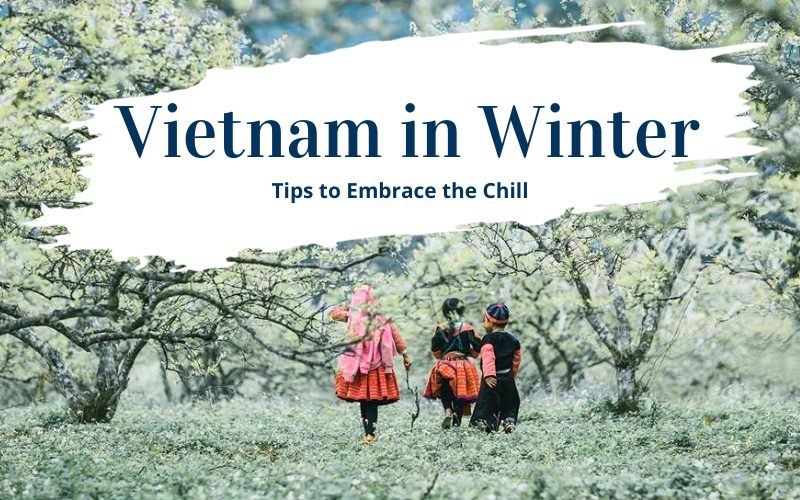
Winter is widely regarded as the ideal season to discover the Northern regions of Vietnam, given the captivating landscapes that come alive during this time. If you are planning to visit Vietnam in winter, this article is going to equip you with essential information about the nation’s winter climate. Additionally, it will highlight some must-visit destinations to ensure you get the most out of your Vietnamese adventure.
An Overview of Winter in Vietnam
Vietnam boasts a diverse climate shaped by its varied geography, encompassing mountainous terrains, coastal stretches, and tropical islands. These landscapes collectively create distinct weather patterns. Delve deeper into Vietnam weather in winter to effectively strategize your journey and maximize your experience in this remarkable country!
When is Winter in Vietnam?
In Vietnam, winter typically occurs from December to February. However, it’s essential to understand that Vietnam’s climate varies significantly from north to south due to its elongated shape. In the northern regions, such as Hanoi and Sapa, winter can be cooler with temperatures dropping to as low as 10°C (50°F) or even lower in mountainous areas. This is the closest to a “winter” experience you can have in Vietnam with occasional cold spells and foggy conditions.
In central Vietnam, the weather during these months is generally mild and dry. The southern part, including Ho Chi Minh City, experiences a tropical climate, so there isn’t a traditional winter. Instead, the dry season starts from November to April, with temperatures being warm but less humid than the wet season.
How is the Weather in Vietnam in Winter?
Winter in Vietnam offers a mix of cool to warm temperatures depending on the region. The north gives a genuine winter feel, central areas are mild and dry, while the south remains warm and dry. This diversity in climate allows travelers to experience a range of weather conditions in a single trip, making winter an intriguing time to explore Vietnam.
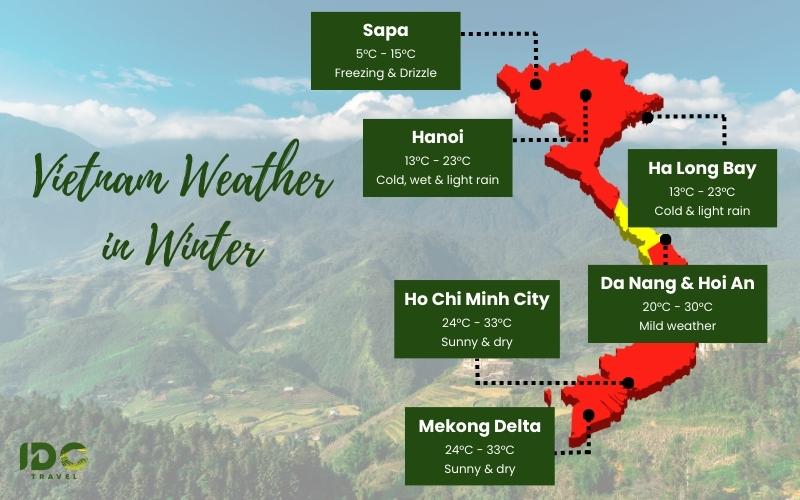
Vietnam weather in winter
Northern Vietnam (e.g., Hanoi, Sapa, Ha Long Bay)
Winter in the northern region stretches from December to February. During these months, temperatures can drop to as low as 10°C (50°F), especially in places like Sapa, which is located in the mountains. In Hanoi, the capital, temperatures typically hover between 10°C to 20°C. The weather is generally cool and can get chilly, with occasional drizzles and high humidity. Cold snaps can sometimes bring temperatures even lower, especially in mountainous areas.
Central Vietnam (e.g., Hue, Da Nang, Hoi An)
The central part of Vietnam experiences a milder winter. From December to February, the region sees moderate temperatures, ranging from 18°C to 24°C. These months are relatively dry, making it a favorable time for travelers.
Southern Vietnam (e.g., Ho Chi Minh City, Can Tho, Phu Quoc)
In the southern regions, there isn’t a traditional winter. The climate here is tropical, so the period from November to April is considered the dry season. During the dry season, the weather is warm, with temperatures ranging from 25°C to 32°C. Humidity levels are lower compared to the wet season, providing a more comfortable atmosphere.
>>> Read more: The Best Time to Visit Vietnam
Best Places to Visit in Vietnam in Winter
Sapa
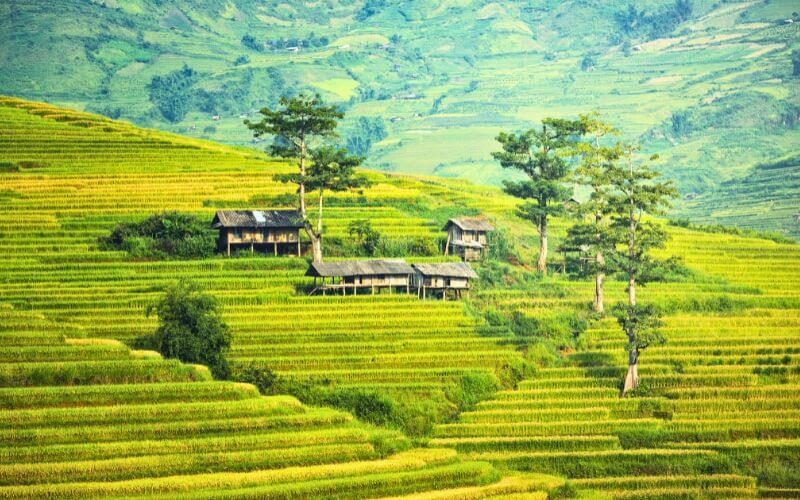
Terraced rice fields in Sapa
In the heart of the northern highlands, Sapa emerges as a winter wonderland. The terraced rice fields, kissed by frost, shimmer under the sun, with valleys blanketed by a rolling mist. On rare occasions, snow graces this region, turning it into a magical white landscape. Beyond the beauty, trek through the countryside to experience the indigenous culture of local ethnic communities.
Hanoi
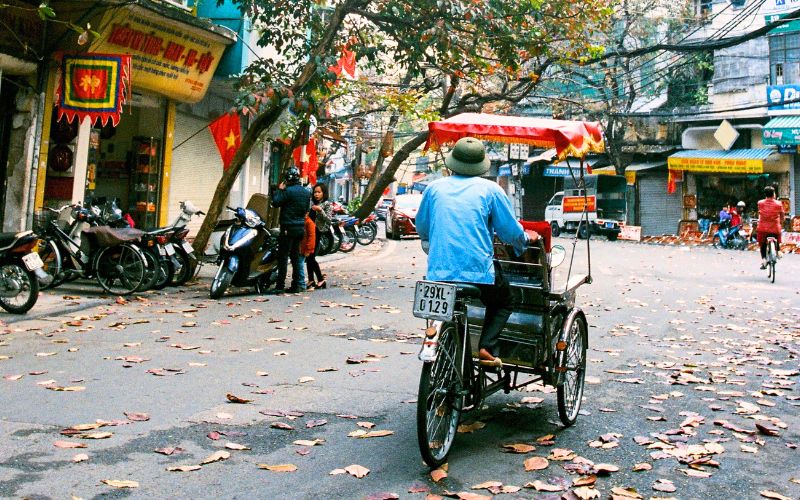
Hanoi Old Quarter
The capital city, Hanoi, dons a festive spirit in winter. The crisp air is perfect for meandering through the historic Old Quarter, where colonial architecture blends with traditional craft shops. Hanoi’s landmarks, such as the Ho Chi Minh Mausoleum and Temple of Literature, are a must-visit. Warm up with iconic local dishes, like pho or egg coffee, as they taste even better in the cold.
Ha Long Bay

Kayaking in Halong Bay
Ha Long Bay in winter is nothing short of mystical. The iconic limestone karsts, often veiled in a thin mist, create an enchanting atmosphere. Winter sees fewer tourists, giving you a more secluded and intimate experience. It is best to explore this wonder of Vietnam on a 2-day or 3-day cruise as you will have enough time to witness magnificent limestone karts, join thrilling water activities, immerse yourself in the pristine clear water with swimming or kayaking, and even get your luck with night squid fishing on the boat.
Ha Giang
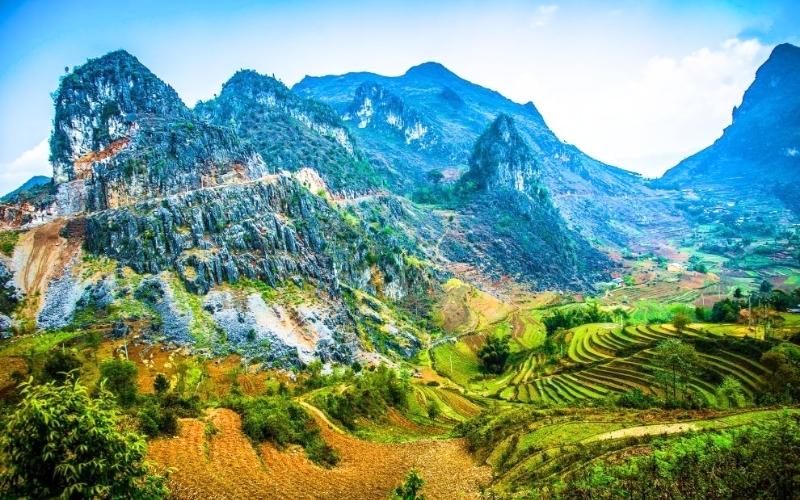
Dong Van Global Karst Plateau Geopark
For those seeking off-the-beaten-path experiences, Ha Giang awaits. Home to the Dong Van Karst Plateau Geopark, a UNESCO Global Geopark, this region showcases striking rock landscapes, ancient fossils, and rich cultural diversity. Winter paints this canvas with a misty hue, amplifying its allure. The mist-wrapped limestone formations promise a surreal experience for every traveler.
Hue
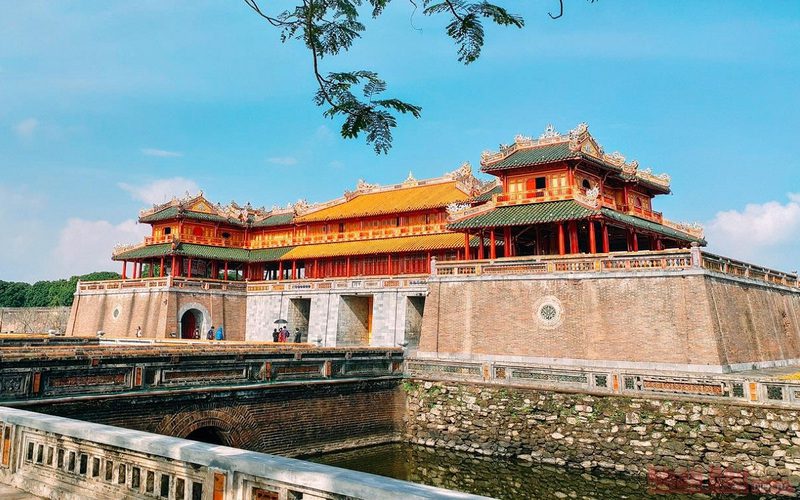
The Imperial City of Hue
What can you expect from Hue during winter? The climate is gentler in these months, ensuring a comfortable visit. Opting to explore Hue in January or February means fewer tourists, allowing for a more intimate experience.
Central Vietnam’s iconic Perfume River takes on a special ambiance in December. The cool misty aura combined with crisp air lends a romantic atmosphere. While snow is a rarity in Hue, don’t forget to bring a cozy hat and jacket because temperatures can drop. Delve into the delectable Central Vietnamese cuisine. Imagine savoring a piping hot bowl of bun bo Hue on a chilly day – it’s a culinary delight!
Ho Chi Minh City
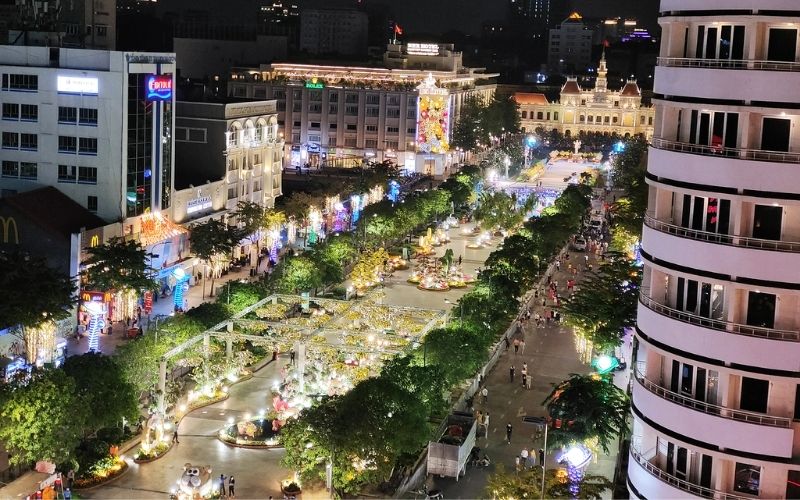
Nguyen Hue Walking Street in Ho Chi Minh City
Ho Chi Minh City transforms into a winter wonderland in Vietnam. This dynamic, bustling economic center enjoys its most delightful weather from December to March, with average temperatures ranging from 23°C to 31°C. The cool evenings only add to the city’s charm. While Southern Vietnam typically witnesses its peak rainfall between July to September, the dryness of winter becomes a refreshing change.
Specifically, January and February are ideal times to explore Saigon, especially as Tet – the Lunar New Year – approaches. The city vibrates with festive energy, adorned with decorations everywhere in anticipation of Vietnam’s grandest celebration. Markets overflow with festive goods and offerings. Don’t miss the vibrant flower markets and the many Tet-related festivities during this period!
Mekong Delta
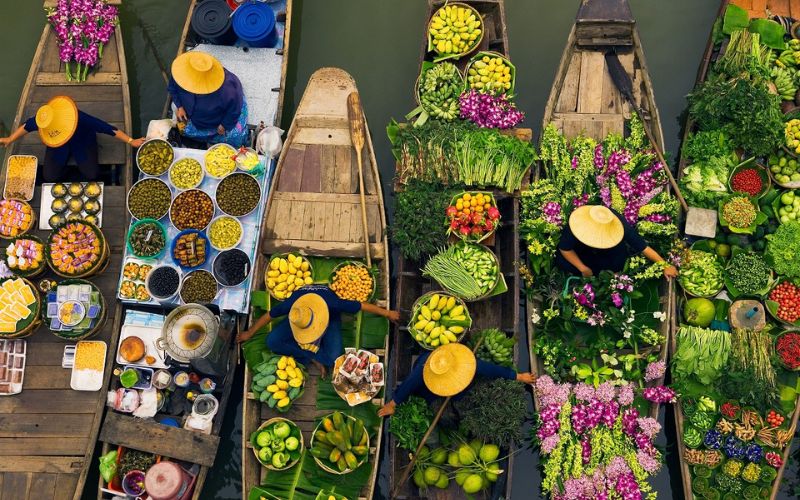
A floating market in the Mekong Delta
The Mekong Delta is often hailed as one of the prime destinations in Vietnam for a visit during January and February. These months steer clear of the rainy season, resulting in reduced humidity, adding comfort to the experience. The floral landscape peaked during this time, painting the region vibrant and aromatic. An added advantage is the decreased mosquito and insect activity due to the cooler weather, making explorations more enjoyable.
This delta region presents Vietnam in a light distinct from other parts of the country. Visitors can delve into the rich history and vibrant culture by navigating through its iconic floating markets in quaint boats or relish a tranquil cruise amidst the verdant water channels.
Festivals in Vietnam in Winter
Christmas Eve
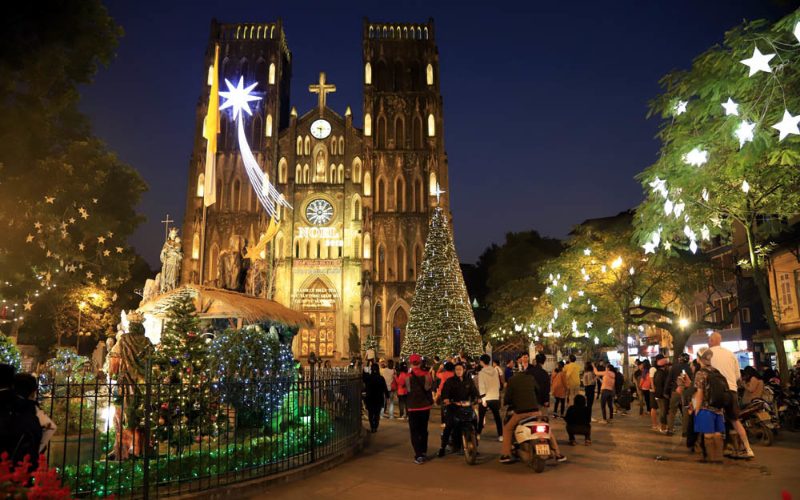
Christmas Eve at St. Joseph Cathedral in Hanoi
While only a small percentage of the Vietnamese population identifies as Christian, Christmas Eve has become a prominent celebration in many of Vietnam’s major cities. On the night of December 24th, the streets of Hanoi and Ho Chi Minh City come alive with throngs of people eager to immerse themselves in the festive spirit. They gather to admire the radiant decorations and lights adorning Catholic Cathedrals or to capture memories at the beautifully decked-out exteriors of grand hotels and shopping centers. The tradition of Santa Claus delivering gifts to children has also gained popularity in recent times.
Traditional Tet Holiday
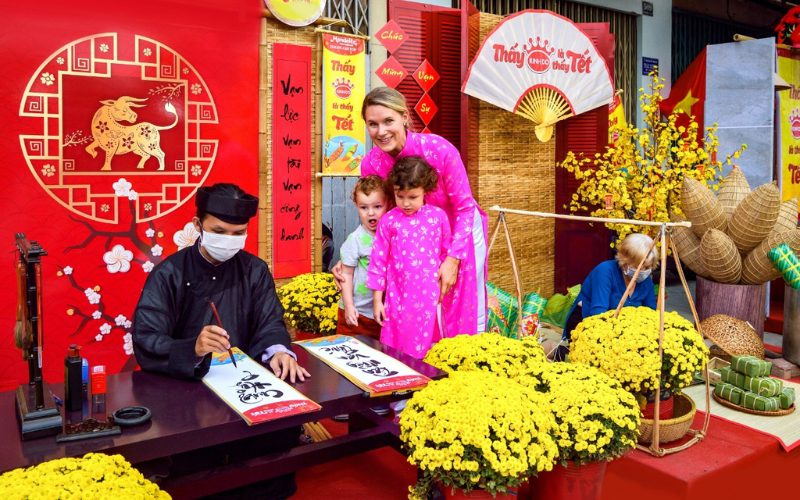
Tet decorations in Ho Chi Minh City
Tet, the Vietnamese Lunar New Year, coincides with the Chinese New Year, typically landing in January or February. Although this national holiday in Vietnam is officially three days long, it’s not uncommon for celebrations to extend up to a week or even ten days. The lead-up to Tet is a flurry of activity, with individuals shopping, tidying their homes, and preparing festive dishes. Traditions during Tet include honoring ancestors, gifting “lucky money” to children and the elderly, and other cultural practices that reflect Vietnam’s rich heritage. For those considering a visit to Vietnam during the Tet celebrations, it’s advisable to secure air or train tickets and accommodations ahead of time.
Perfume Pagoda Festival
The Perfume Pagoda (Chua Huong) in Hanoi is a significant attraction, drawing numerous local pilgrims and tourists from across Vietnam to its annual festival. Visitors journey by boat to the base of Huong Mountain and then proceed on foot to the Huong Tich cave. This festival typically takes place as winter concludes, around mid-February to early March.
Suggested Itineraries for Winter Trip in Vietnam
Experiencing Vietnam in winter offers unique insights and visuals. Different regions showcase distinct vistas and cultural celebrations that are truly unforgettable. With its unparalleled natural beauty, delectable cuisine, and remarkable temples, Vietnam has a lot to offer. So, why wait? Embrace the wonders of Vietnam this winter and immerse yourself in its rich offerings.
Itinerary 1: 1 Week in Vietnam
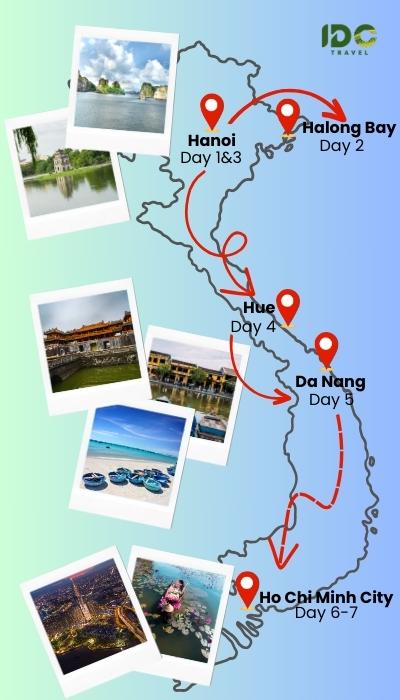
Day 1: Arrive in Hanoi. If time permits, you will have a tour around Hanoi Old Quarter before watching the Water Puppet Show.
Day 2: Full-day exploring Ha Long Bay on a 4-hour cruise. Here, you will have a chance to admire the beautiful Stone Dog, Incense Burner, and Fighting Cock islets and explore the famous Thien Cung Cave.
Day 3: Hanoi City tour, visit Ho Chi Minh Mausoleum, One Pillar Pagoda, and the Temple of Literature. Fly to Hue in the afternoon.
Day 4: Hue City tour, check out the Royal Citadel, Imperial Museum, and Khai Dinh Tomb. In the afternoon, enjoy a boat ride down the Huong River to visit Thien Mu Pagoda. Finally, stop at Dong Ba Market.
Day 5: Drive to Da Nang, and visit Cham Museum and Marble Mountain. Afternoon transfer to Hoi An and join a walking tour around the ancient town. Here, you will visit the Japanese Covered Bridge, Tan Ky ancient house, etc., and join a lantern-making workshop.
Day 6: Fly to Ho Chi Minh City in the early morning. Then, visit the Reunification Palace, Notre Dame Cathedral, and Saigon Central Post Office. Have a delightful night at Bui Vien walking street if you want.
Day 7: Depart Ho Chi Minh City.
>>> See the full itinerary at our Classic Tour in Vietnam in 7 Days.
Similar tours:
- Discover the Central Vietnam Highlands in 7 Days
- Northern Vietnam Wellness Retreat 7 Days
- Family Deltas Tour in Vietnam in 7 Days
Itinerary 2: 2 Weeks in Vietnam
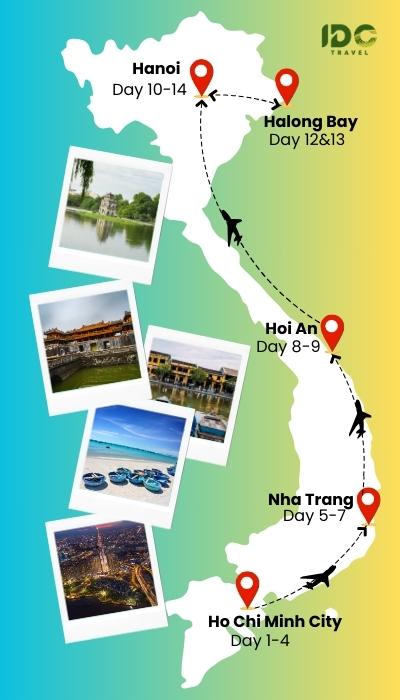
Day 1: Arrive in Ho Chi Minh City.
Day 2: Ho Chi Minh City tour, check out War Remnants Museum, Saigon Opera House, Saigon Central Post Office, and the City Hall.
Day 3 – 4: Explore the Mekong Delta and join brisk construction, fishing, and coconut candy-making workshops in Ben Tre. Then, transfer to Can Tho for overnight sleep. Go shopping at Cai Rang Floating Market before returning to Ho Chi Minh City.
Day 5: Fly to Nha Trang.
Day 6: Spend a day at Vinpearl Amusement Park with a lot of thrilling activities.
Day 7: Free time to explore Nha Trang beach.
Day 8: Transfer to Hoi An and join a walking tour around the ancient town, visit the Tan Ky House, Chua Ong Pagoda, and the Pottery Museum.
Day 9: Explore Tra Que Herbal Village, where you can ride a bike through beautiful paddies and join a cooking class to make Spring rolls and Banh Xeo. Afternoon return to the main town and watch Hoi An Memory Show.
Day 10: Fly to Hanoi.
Day 11: Hanoi city tour over Ho Chi Minh Mausoleum, One Pillar Pagoda, Vietnam Museum of Ethnology, and the lively Old Quarter.
Day 12 – 13: Explore Ha Long Bay on a 2-day 1-night cruise boat.
Day 14: Depart Hanoi.
>>> For the comprehensive itinerary, please check it here. If you are a newly wedded couple, please refer to our Enchanting Honeymoon Tour through Vietnam 14 days for a more favorable itinerary.
Itinerary 3: 3 Weeks in Vietnam
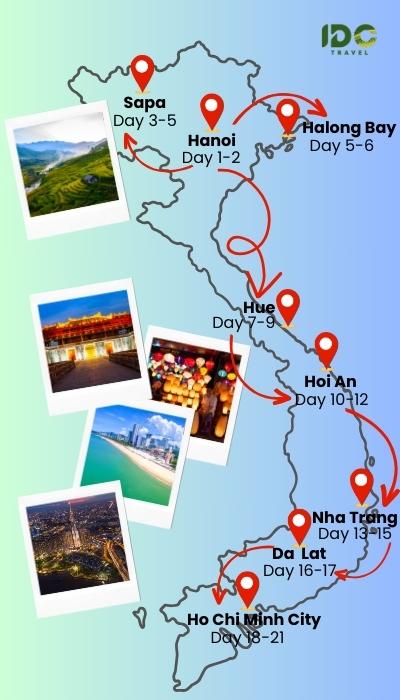
Day 1: Arrive in Hanoi
Day 2: Hanoi City tour, Ho Chi Minh Mausoleum, One Pillar Pagoda, Tran Quoc Pagoda, and finally the Temple of Literature. Night train to Sapa.
Day 3 – 4: In Sapa, go trekking at Lao Chai and Ta Van villages as well as come across Giang Ta Chai village and Bac Ha Ethnic Market. Night train to Ha Noi.
Day 5 – 6: Embark on a 2-day 1-night Ha Long Bay cruise, and spend your time exploring the overwhelming seascape.
Day 7: Fly from Hanoi to Hue. Free time to relax after checking in at the hotel.
Day 8 – 9: Hue City tour, visit the Imperial Citadel, Thai Hoa Palace, Nine Dynastic Urns, the Mandarin Halls, and the Forbidden Purple City. Outside of Hue, you will see Thien Mu Pagoda and Minh Mang Emperor’s Tomb.
Day 10 – 12: Leave Hue for Hoi An. You will have 3 days to explore all of Hoi An’s highlights, such as the Japanese Covered Bridge, Sa Huynh Museum, and My Son Sanctuary.
Day 13 – 15: Leave Hoi An to Nha Trang City. Time to relax on Nha Trang’s pristine beaches and famous tourist attractions like Islandland, and Tri Nguyen Aquarium.
Day 16 – 17: Transfer to Da Lat by car and take a short walk to discover the city on foot upon arrival. On the next day, you will visit Da Lat’s highlights, including the Crazy House, Truc Lam Monastery, and Tri Mat Village.
Day 18: Fly to Ho Chi Minh City.
Day 19: A day visiting the city’s attractions like Notre Dame Cathedral, Central Post Office, the Reunification Palace, and War Remnants Museum.
Day 20: Visit My Tho – a significant part of the Mekong Delta, which is surrounded by rice paddies and orchards; join hands in making coconut candies and harvesting bee products.
Day 21: Depart Ho Chi Minh City.
>>> To know the exact tour itinerary, please check out our Explore Vietnam Highlights in 21 Days tour.
Vietnam Winter Packing Tips
To have a smooth experience in Vietnam in winter, just remember these following simple packing tips:
- Warm Attire: With temperatures in Vietnam potentially dipping to 10°C (50°F) or even below during winter, packing warm essentials like jackets, snug sweaters, scarves, and hats is crucial for comfort.
- Sturdy Footwear: Vietnam’s winter adventures often involve ample walking and exploration. Ensure you have shoes that are both comfy and apt for the chilly conditions.
- Weatherproof Gear: Even though Vietnam’s winter is predominantly dry, rain can be an occasional guest, especially in the north. It’s wise to have a raincoat or umbrella on hand.
- Photography Essentials: The mesmerizing winter landscapes of Vietnam are a photographer’s delight. Don’t forget to bring along a quality camera to freeze those enchanting moments.
- Layer Up: Given the day’s varying temperatures, dressing in layers is a smart move. Start with a toasty base layer and add on, ensuring you can easily adapt to the changing conditions.
- Hand & Head Protection: Hands are usually the first to feel the nip. Packing warm gloves and a hat to shield your ears and hands from the cold is a good idea.
- Embrace Local Fashion: Many Vietnamese locals don a long, slender traditional scarf during colder months. Consider buying one; it serves as both a functional accessory to keep warm and a cherished memento.
Have you chosen a suitable itinerary for your winter trip to Vietnam? Not yet, you can refer to our list of well-planned Vietnam tours for more options. Or, contact us right now to tailor-make your tour program.
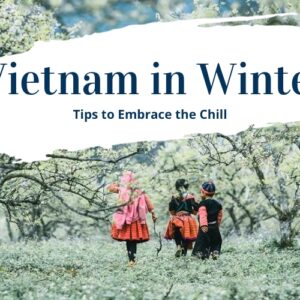


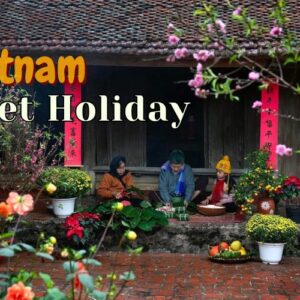
I never considered visiting Vietnam in winter until reading this post. The idea of exploring Sapa’s terraced fields with a light mist in the air sounds magical. The tips on packing warm clothes and enjoying hot pho in cooler weather are much appreciated. Looking forward to planning a winter trip now!
Thank you so much for your comment! We’re glad the post inspired you to consider Vietnam in winter. We hope you have an amazing time planning your winter trip and get to experience all the charm Vietnam has to offer!
What is the coldest city in Vietnam in winter?
Hi Dione,
There is winter in Northern Vietnam only and two coldest cities are Hanoi and Sa Pa with the temperature sometimes drops to as low as as 10°C (50°F). Also, December is the coldest month, ideal for outdoor activities like mountain climbing, sightseeing, etc.
Hope to see you in Vietnam in the upcoming time.
Best regards,
Alice Pham.